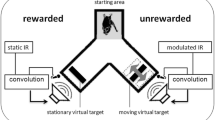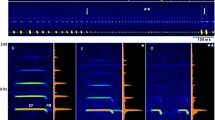Summary
Bats of the speciesNoctilio albiventris emit short-constant frequency/frequency modulated (short-CF/FM) pulses with a CF component frequency at about 75 kHz. Bats sitting on a stationary platform were trained to discriminate target distance by means of echolocation. Loud, free-running artificial pulses, simulating the bat's natural CF/FM echolocation sounds or with systematic modifications in the frequency of the sounds, were presented to the bats during the discrimination trials. When the CF component of the artificial CF/FM sound was between 72 and 77 kHz, the bats shifted the frequency of the CF component of their own echolocation sounds toward that of the artificial pulse, tracking the frequency of the artificial CF component.
Bats flying within a large laboratory flight cage were also presented with artificial pulses. Bats in flight lower the frequency of their emitted pulses to compensate for Doppler shifts caused by their own flight speed and systematically shift the frequency of their emitted CF component so that the echo CF frequency returns close to that of the CF component of the artificial CF/FM pulse, over the frequency range where tracking occurs.
Similar content being viewed by others
Abbreviations
- CF :
-
constant frequency
- FM :
-
frequency modulation
References
Bloedel P (1955) Hunting methods of fish-eating bats, particularlyNoctilio leporinus. J Mammal 36:390–399
Goldman LJ, Henson OW (1977) Prey recognition and selection by the constant frequency batPteronotus p. parnellii. Behav Ecol Sociobiol 2:411–420
Habersetzer J (1981) Adaptive echolocation sounds in the batRhinopoma hardwickei. J. Comp Physiol 144:559–566
Miller LA, Degn HJ (1981) The acoustic behavior of four species of vespertilionid bats studied in the field. J Comp Physiol 142:64–74
Pye JD (1972) Bimodal distribution of constant frequencies in some hipposiderid bats. J Zool 166:323–355
Roverud RC, Grinnell AD (1985a) Discrimination performance and echolocation signal integration requirements for target detection and distance determination in the CF/FM bat,Noctilio albiventris. J Comp Physiol A 156:447–456
Roverud RC, Grinnell AD (1985b) Echolocation sound features processed to provide distance information in the CF/FM bat,Noctilio albiventris: evidence for a gated time window utilizing both CF and FM components. J Comp Physiol A 156:457–469
Schnitzler HU (1968) Die Ultraschall-Ortungslaute der Hufeisenfledermäuse (Chiroptera Rhinolophidae) in verschiedenen Orientierungssituationen. Z Vergl Physiol 57:376–408
Schnitzler HU (1970) Echoortung bei der FledermausChilonycteris rubiginosa. Z Vergl Physiol 68:35–38
Schnitzler HU (1979) Echoortung bei der FledermausChilonycteris rubiginosa. Z Vergl Physiol 68:35–38
Schnitzler HU (1978) Die Detektion von Bewegung durch Echoortung bei Fledermäusen. Verh Dtsch Zool Ges 1978:16–33
Schnitzler HU, Ostwald J (1982) Adaptations for the detection of fluttering insects by echolating bats. In: Ewert JP, Capranica RR, Ingle DJ (eds) Advances in vertebrate neuroethology. Plenum Press, New York London, pp. 801–821
Schnitzler HU, Menne D, Rudi K, Heblich K (1984) The acoustical image of fluttering insects in echolocating bats. In: Huber F, Markl H (eds) Neuroethology and behavioral physiology. Roots and growing points. Springer Berlin Heidelberg New York, pp 235–250
Schuller G (1979) Coding of small sinusoidal frequency and amplitude modulations in the inferior colliculus of ‘CF/FM’ bat,Rhinolophus ferrumequinum. Exp Brain Res 34:117–132
Schuller G, Beuter K, Schnitzler HU (1974) Response to frequency shifted artificial echoes in the batRhinolophus ferrumequinum J Comp Physiol 89:275–286
Simmons JA (1974) Response of the Doppler echolocating system in the batRhinolophus ferrumequinum. J Acoust Soc Am 56:672–682
Suthers RA, Fattu JM (1973) Fishing behavior and acoustic orientation by the batNoctilio labialis. Anim Behav 21:61–66
Wenstrup JJ (1984) Auditory sensitivity in the fish-catching bat,Noctilio leporinus. J Comp Physiol A 155:91–101
Wenstrup JJ, Suthers R (1984) Echolocation of moving targets by the fish-catching bat,Noctilio leporinus. J Comp Physiol A 155:75–89
Author information
Authors and Affiliations
Rights and permissions
About this article
Cite this article
Roverud, R.C., Grinnell, A.D. Frequency tracking and Doppler shift compensation in response to an artificial CF/FM echolocation sound in the CF/FM bat,Noctilio albiventris . J. Comp. Physiol. 156, 471–475 (1985). https://doi.org/10.1007/BF00613971
Accepted:
Issue Date:
DOI: https://doi.org/10.1007/BF00613971




